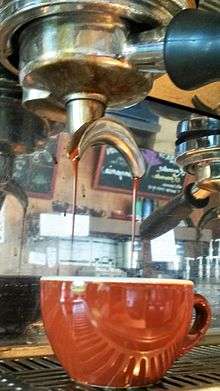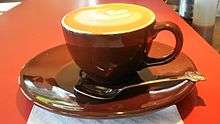Coffee cup

A coffee cup is a container that coffee and espresso-based drinks are served in. Coffee cups are typically made of glazed ceramic, and have a single handle for portability while the beverage is hot. Ceramic construction allows a beverage to be drunk while hot, providing insulation to the beverage, and quickly washed with cold water without fear of breakage, compared to typical glassware.
A coffee cup may also be a disposable cup in which hot beverages, including coffee, can be contained. Disposable coffee cups may be made out of paper or styrofoam. At coffee shops, paper cups are commonly used to give beverages to customers on the go, usually with a coffee cup sleeve to provide insulation against heat transferred through the container.
Some coffee cups are served.
History
In the past, other materials which have been used to make coffee cups are clay, wood, strengthened glass, metal, ceramic and porcelain.
Coffee cup lids
Usually made of plastic, the first patent for a coffee cup lid design was filed in 1967, and focused on creating a tight seal between the cup and the lid to reduce leaking and a vent hole to allow steam to escape.[1][2][3] However, there was no opening for drinking, and the consumer would have to tear into the lid.[4] In 1986, the Solo Traveler lid was created; it is found in the Museum of Modern Art’s 2004 exhibit "Humble Masterpieces.".[5][6] Recent lid designs like the Viora have improved on Solo Traveler's design, which has too small a vent to allow sufficient air to enter while drinking.[2] Louise Harpman, owner of the world’s largest collection of coffee cup lids, suggests that coffee cup lids “represent a major shift in American ‘to-go’ culture.”[7]
Shapes and sizes
Cafe drinkware
.jpg)
There are cafe cups in various sizes, standardized to reflect paper cup sizes. They are typically 225, 336, 460 and sometimes 570 ml. Slight variation is to be expected from coffeehouse to coffeehouse, but these sizes are the standard. These are the cups that house mochas, lattes, and other coffee drinks. These cups are also made of porcelain and shaped to encourage and aid in creating latte art.
Cappuccino

The cappuccino is served in its own cup, a 171 ml porcelain cup served on an accompanying saucer. The size of the cup reflects the traditional cappuccino, a drink with a 1:1:1 ratio. 57 ml espresso, 57 ml steamed milk, 57 ml integrated foam.[8]
Demitasse
The Demitasse is a cup specially crafted for espresso. It is 60-80 ml in capacity, and usually served on a saucer. The traditional macchiato: 2 shots of espresso and a dollop of foam is also served in the demitasse, on an accompanying saucer.
Gibraltar or cortado
The “Gibraltar” or cortado is served in a 115 ml rocks glass.[9]
Shape innovation
NASA designed "Space Cups" for use by astronauts in the International Space Station. The specially-shaped coffee cups, which are 3D printed, can be used to replace the old method of drinking liquids in space by sucking them out of a bag. The sharp inner corner of the Space Cup allows the liquid to flow toward the drinker's lips through capillary flow. The data from experiments conducted with Space Cups can be used to better the design of fluid systems used in space, such as toilets, oxygen, air conditioning, and water coolants. The data can also be applied to societal uses of fluid systems on Earth, such as improving the design of portable medical blood testers for infectious diseases.[10]
Materials


Porcelain
Porcelain allows for heat retention and crema preservation. However porcelain cools down quickly due to air bubbles in the cup. Crema is the coffee foam at the top of a shot of espresso. Preserving it in cups allows for latte art to occur in milk based espresso drinks.
Paper
Paper cups may be lined with wax or plastic to prevent leakage. The Anthora paper cup designed by Leslie Buck for the Sherri Cup Company in 1963 is recognized as an iconic part of New York City daily life.[11][12]
Polystyrene
Polystyrene, better known under the trademarked brand name Styrofoam, is used mostly because of its insulating abilities. The use of polystyrene is controversial in coffee cups and other containers because it is non-biodegradable,[13][14] a major part of marine litter,[15] difficult to recycle, and has various health risks. It is banned as a food and drink container in several U.S. cities including Portland, Ore.; San Francisco, Calif.; and Amherst, Mass.[16] Many more cities are proposing banning the cups. The doughnut company and coffeehouse chain, Dunkin’ Donuts, has been criticized for continuing to use styrofoam cups. The company has argued that there is no other material that is as insulated,[17] and has an official statement about their foam cups on their website.[18] However, they have begun phasing in doubled-walled paper cups designed to look like their signature foam cup.[19]
Coffee cup sleeve
Coffee cup sleeves are roughly cylindrical sleeves that fit tightly over handle-less paper coffee cups to insulate the drinker's hands from hot coffee. The coffee sleeve was invented and patented by Jay Sorensen in 1993 and are now commonly utilized by coffee houses and other vendors that sell hot beverages dispensed in disposable paper cups. Coffee sleeves are typically made of textured paperboard, but can be found made of other materials.
References
| Wikimedia Commons has media related to Coffee cup. |
- ↑ Garber, Megan (2011-05-09). "The Rise of the Plastic, Disposable Coffee Cup Lid - Nicola Twilley". The Atlantic. Retrieved 2014-05-20.
- 1 2 "Daily Coffee News by Roast Magazine – To-Go Cup Lid Makers Hoping to Capitalize On 'Third Wave' Success". Dailycoffeenews.com. 2014-05-02. Retrieved 2014-05-20.
- ↑ "Patent US3421681 - Cup and lid - Google Patents". Google.com. Retrieved 2014-05-20.
- ↑ Kennedy, Pagan (2013-10-25). "Who Made That Coffee Lid?". The New York Times.
- ↑ "Patent US4589569 - Lid for drinking cup - Google Patents". Google.com. 1983-10-24. Retrieved 2014-05-20.
- ↑ "Humble Masterpieces". MoMA. 2004-09-27. Retrieved 2014-05-20.
- ↑ "History, Travel, Arts, Science, People, Places | Smithsonian". Smithsonianmag.com. Retrieved 2014-05-20.
- ↑ "cappuccino: definition of cappuccino in Oxford dictionary (American English) (US)". Oxforddictionaries.com. 2014-05-14. Retrieved 2014-05-20.
- ↑ Nguyen, Tien (2013-10-03). "Drink This Now: Cognoscenti Coffee's On-the-Menu Cortado | Squid Ink | Los Angeles | Los Angeles News and Events". LA Weekly. Retrieved 2014-05-20.
- ↑ Regan, Helen (4 May 2015). "Astronauts Now Enjoy Espresso Out of Special Cups". TIME.com. Retrieved 6 May 2015.
- ↑ Fox, Margalit (2010-04-29). "Leslie Buck, Designer of Iconic Coffee Cup, Dies at 87". The New York Times.
- ↑ "Urban History to Go: Black, No Sugar". The New York Times. 2005-06-26.
- ↑ "Drinking Coffee in a Styrofoam Cup? Pour It Out". Rodale News. Retrieved 2014-05-20.
- ↑ "Studies on photocatalytic degradation of polystyrene". Maney Online. Retrieved 2014-05-20.
- ↑ "Marine Litter". kimointernational.org.
- ↑ Matthew Daneman, USA TODAY (21 December 2013). "More cities ban polystyrene foam, citing environment". USA TODAY.
- ↑ "Dunkin' Donuts Opposes Proposed Somerville Styrofoam Ban". Somerville, Massachusetts Patch.
- ↑ "FAQs". DunkinDonuts.com.
- ↑ "Dunkin' Donuts introduces paper coffee cups in Brookline - Business - The Boston Globe". BostonGlobe.com.
